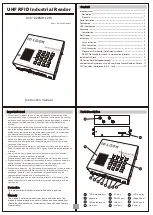
Appendix A
Specifications for Maximum Signal Ratings for AT Series Devices
A-38
ni.com
Electromagnetic Compatibility
CE, C-Tick, and FCC Part 15 (Class A) Compliant
Electrical emissions ................................EN 55011 Class A at 10 m
FCC Part 15A above 1 GHz
Electrical immunity ................................Evaluated to EN 61326:1998,
Table 1
Note
For full EMC compliance, you must operate this device with shielded cabling.
In addition, all covers and filler panels must be installed. Refer to the Declaration of
Conformity (DoC) for this product for any additional regulatory compliance information.
To obtain the DoC for this product, click
Declaration of Conformity
at
ni.com/hardref.nsf/
.
This Web site lists the DoCs by product family. Select the
appropriate product family, followed by the product, and a link to the DoC appears in
Adobe Acrobat format. Click the Acrobat icon to download or read the DoC.
Maximum Signal Ratings for AT Series Devices
Note
NI is
not
liable for any damage resulting from signal connections that exceed these
ratings. Refer to the warranty for specific information on warranty coverage.
Connections that exceed any of the maximum ratings of input signals on the
data acquisition (DAQ) devices listed in the table below can damage the
computer and the device.
Note
These are the absolute maximum ratings of the input signals, not the working
ratings. Refer to the user manual for the recommended operating conditions of the device.
Use the following specifications as definitive values. Signal ratings change
depending on whether the DAQ device is powered on or off.
Signal Name
AT-MIO-16E-1
AT-MIO-16E-2
AT-MIO-64E-3
AT-MIO-16XE-10
AT-AI-16XE-10
AT-MIO-16E-10
AT-MIO-16DE-10
AT-MIO-16XE-50
On
Off
On
Off
On
Off
ACH<
x
>
±25 V
±15 V
±35 V
±25 V
±25 V
±15 V
AISENSE
±25 V
±15 V
±35 V
±25 V
±25 V
±15 V
















































